Editor’s note: The following is extracted from Hunting in Many Lands: The Book of the Boone and Crockett Club (published 1895).
The little hunting I did in 1893 and 1894 was while I was at my ranch house, or while out on the range among the cattle; and I shot merely the game needed for the table by myself and those who were with me. It is still possible in the cattle country to kill an occasional bighorn, bear or elk; but nowadays the only big game upon which the ranchman of the great plains can safely count are deer and antelope. While at the ranch house itself, I rely for venison upon shooting either blacktail in the broken country away from the river, or else whitetail in the river bottoms. When out on the great plains, where the cattle range freely in the summer, or when visiting the line camps, or any ranch on the heads of the longer creeks, the prongbuck furnishes our fresh meat.
In both 1893 and 1894 I made trips to a vast tract of rolling prairie land, some fifty miles from my ranch, where I have for many years enjoyed the keen pleasure of hunting the prongbuck. In 1893 the pronghorned bands were as plentiful in this district as I have ever seen them anywhere. A friend, a fellow Boone and Crockett man, Alexander Lambert, was with me; and in a week’s trip, including the journey out and back, we easily shot all the antelope we felt we had any right to kill; for we only shot to get meat, or an unusually fine head.
In antelope shooting more cartridges are expended in proportion to the amount of game killed than with any other game, because the shots are generally taken at long range; and yet, being taken in the open, there is usually a chance to use four or five cartridges before the animal gets out of sight. These shots do not generally kill, but every now and then they do; and so the hunter is encouraged to try them, especially as after the first shot the game has been scared anyway, and no harm results from firing the others.
In 1893, Lambert, who was on his first hunt with the rifle, did most of the shooting, and I myself fired at only two antelope, both of which had already been missed. In each case a hard run and much firing at long ranges, together with in one case some skillful maneuvering, got me my game; yet one buck cost nine cartridges and the other eight. In 1894 I had exactly the reverse experience. I killed five antelope for thirty-six shots, but each one that I killed was killed with the first bullet, and in not one case where I missed the first time did I hit with any subsequent one. These five antelope were shot at an average distance of about 150 yards. Those that I missed were, of course, much further off on an average, and I usually emptied my magazine at each. The number of cartridges spent would seem extraordinary to a tyro; and a very unusually skillful shot, or else a very timid shot who fears to take risks, will of course make a better showing per head killed; but I doubt if men with much experience in antelope hunting, who keep an accurate account of the cartridges they expend, will see anything out of the way in the performance. During the thirteen years I have hunted in the West I have always, where possible, kept a record of the number of cartridges expended for every head of game killed, and of the distances at which it was shot. I have found that with bison, bears, moose, elk, caribou, big-horn and white goats, where the animals shot at were mostly of large size and usually stationary, and where the mountainous or wooded country gave chance for a close approach, the average distance at which I have killed the game has been eighty yards, and the average number of cartridges expended per head slain three: one of these representing the death shot and the others standing either for misses outright, of which there were not very many, or else for wounding game which escaped, or which I afterward overtook, or for stopping cripples or charging beasts. I have killed but one cougar and two peccaries, using but one cartridge for each; all three were close up. At wolves and coyotes I have generally had to take running shots at very long range, and I have killed but two for fifty cartridges. Blacktail deer I have generally shot at about ninety yards, at an expenditure of about four cartridges apiece. Whitetail I have killed at shorter range; but the shots were generally running, often taken under difficult circumstances, so that my expenditure of cartridges was rather larger. Antelope, on the other hand, I have on the average shot at a little short of 150 yards, and they have cost me about nine cartridges apiece. This, of course, as I have explained above, does not mean that I have missed eight out of nine antelope, for often the entire nine cartridges would be spent at an antelope which I eventually got. It merely means that, counting all the shots of every description fired at antelope, I had one head to show for each nine cartridges expended. Thus, the first antelope I shot in 1893 cost me ten cartridges, of which three hit him, while the seven that missed were fired at over 400 yards’ distance while he was running. We saw him while we were with the wagon. As we had many miles to go before sunset, we cared nothing about frightening other game, and, as we had no fresh meat, it was worth while to take some chances to procure it. When I first fired, the prongbuck had already been shot at and was in full flight. He was beyond all reasonable range, but some of our bullets went over him and he began to turn. By running to one side I got a shot at him at a little over 400 paces, as he slowed to a walk, bewildered by the firing, and the bullet broke his hip. I missed him two or three times as he plunged off, and then by hard running down a water course got a shot at 180 paces and broke his shoulder, and broke his neck with another bullet when I came up. This one was shot while going out to the hunting ground. While there, Lambert killed four or five; most of the meat we gave away. I did not fire again until on our return, when I killed another buck one day while we were riding with the wagon.
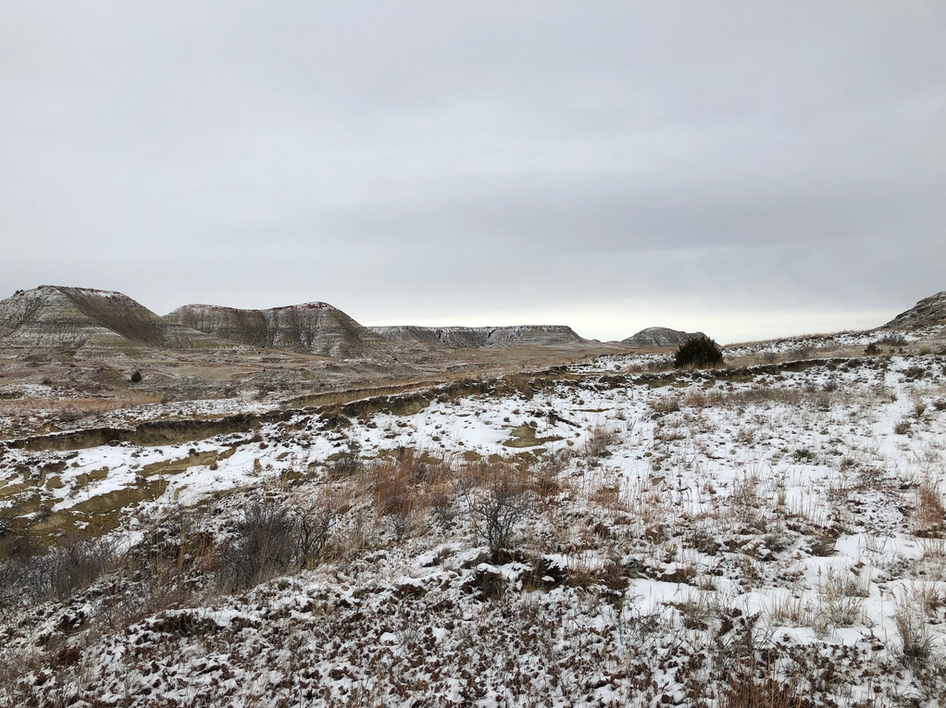
The day was gray and overcast. There were slight flurries of snow, and the cold wind chilled us as it blew across the endless reaches of sad-colored prairie. Behind us loomed Sentinel Butte, and all around the rolling surface was broken by chains of hills, by patches of bad lands, or by isolated, saddle-shaped mounds. The ranch wagon jolted over the uneven sward, and plunged in and out of the dry beds of the occasional water courses; for we were following no road, but merely striking northward across the prairie toward the P. K. ranch. We went at a good pace, for the afternoon was bleak, the wagon was lightly loaded, and the Sheriff, who was serving for the nonce as our teamster and cook, kept the two gaunt, wild-looking horses trotting steadily. Lambert and I rode to one side on our unkempt cow ponies, our rifles slung across the saddle bows.
Our stock of fresh meat was getting low and we were anxious to shoot something; but in the early hours of the afternoon we saw no game. Small parties of horned larks ran along the ground ahead of the wagon, twittering plaintively as they rose, and occasional flocks of longspurs flew hither and thither; but of larger life we saw nothing, save occasional bands of range horses. The drought had been very severe and we were far from the river, so that we saw no horned stock. Horses can travel much further to water than cattle, and, when the springs dry up, they stay much further out on the prairie.
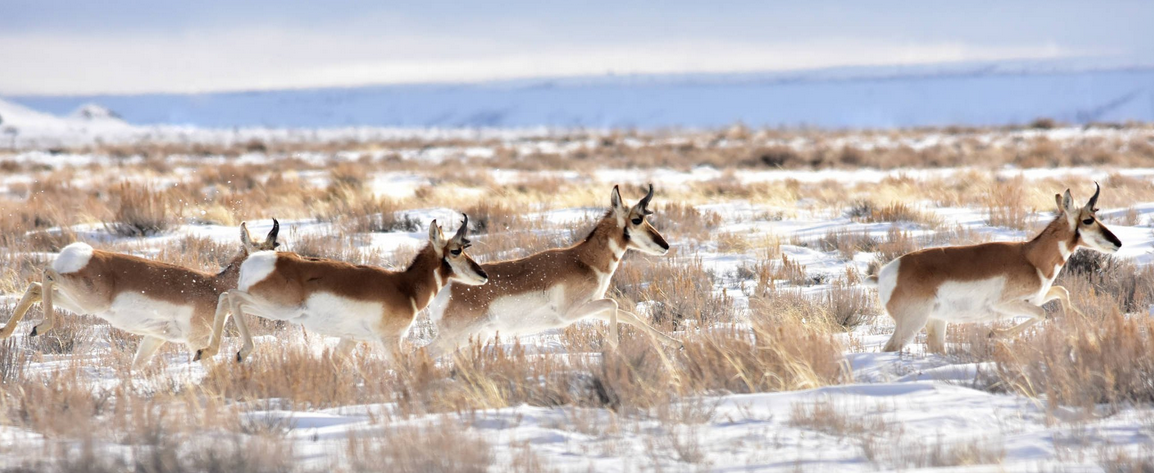
At last we did see a band of four antelope, lying in the middle of a wide plain, but they saw us before we saw them, and the ground was so barren of cover that it was impossible to get near them. Moreover, they were very shy and ran almost as soon as we got our eyes on them. For an hour or two after this we jogged along without seeing anything, while the gray clouds piled up in the west and the afternoon began to darken; then, just after passing Saddle Butte, we struck a rough prairie road, which we knew led to the P. K. ranch—a road very faint in places, while in others the wheels had sunk deep in the ground and made long, parallel ruts.
Almost immediately after striking this road, on topping a small rise, we discovered a young prongbuck standing off a couple of hundred yards to one side, gazing at the wagon with that absorbed curiosity which in this game so often conquers its extreme wariness and timidity, to a certain extent offsetting the advantage conferred upon it by its marvelous vision. The little antelope stood broadside, too, gazing at us out of its great bulging eyes, the sharply contrasted browns and whites of its coat showing plainly. Lambert and I leaped off our horses immediately, and I knelt and pulled the trigger; but the cartridge snapped, and the little buck, wheeling around, cantered off, the white hairs on its rump all erect, as is always the case with the pronghorn when under the influence of fear or excitement. My companion took a hasty, running shot, with no more effect than changing the canter into a breakneck gallop; and, though we opened on it as it ran, it went unharmed over the crest of rising ground in front. We ran after it as hard as we could pelt up the hill, into a slight valley, and then up another rise, and again got a glimpse of it standing, but this time further off than before; and again our shots went wild.
However, the antelope changed its racing gallop to a canter while still in sight, going slower and slower, and, what was rather curious, it did not seem much frightened. We were naturally a good deal chagrined at our shooting and wished to retrieve ourselves, if possible; so we ran back to the wagon, got our horses and rode after the buck. He had continued his flight in a straight line, gradually slackening his pace, and a mile’s brisk gallop enabled us to catch a glimpse of him, far ahead and merely walking. The wind was bad, and we decided to sweep off and try to circle round ahead of him. Accordingly, we dropped back, turned into a slight hollow to the right, and galloped hard until we came to the foot of a series of low buttes, when we turned more to the left; and, when we judged that we were about across the antelope’s line of march, leaped from our horses, threw the reins over their heads, and left them standing, while we stole up the nearest rise; and, when close to the top, took off our caps and pushed ourselves forward, flat on our faces, to peep over. We had judged the distance well, for we saw the antelope at once, now stopping to graze. Drawing back, we ran along some little distance nearer, then drew up over the same rise. He was only about 125 yards off, and this time there was no excuse for my failing to get him; but fail I did, and away the buck raced again, with both of us shooting. My first two shots were misses, but I kept correcting my aim and holding further in front of the flying beast. My last shot was taken just as the antelope reached the edge of the broken country, in which he would have been safe; and almost as I pulled the trigger I had the satisfaction of seeing him pitch forward and, after turning a complete somersault, lie motionless. I had broken his neck. He had cost us a good many cartridges, and, though my last shot was well aimed, there was doubtless considerable chance in my hitting him, while there was no excuse at all for at least one of my previous misses. Nevertheless, all old hunters know that there is no other kind of shooting in which so many cartridges are expended for every head of game bagged.
As we knelt down to butcher the antelope, the clouds broke and the rain fell. Hastily we took off the saddle and hams, and, packing them behind us on our horses, loped to the wagon in the teeth of the cold storm. When we overtook it, after some sharp riding, we threw in the meat, and not very much later, when the day was growing dusky, caught sight of the group of low ranch buildings toward which we had been headed. We were received with warm hospitality, as one always is in a ranch country. We dried our steaming clothes inside the warm ranch house and had a good supper, and that night we rolled up in our blankets and tarpaulins, and slept soundly in the lee of a big haystack. The ranch house stood in the winding bottom of a creek; the flanking hills were covered with stunted cedar, while dwarf cottonwood and box elder grew by the pools in the half-dried creek bed.
Next morning we had risen by dawn. The storm was over, and it was clear and cold. Before sunrise we had started. We were only some thirty miles from my ranch, and I directed the Sheriff how to go there, by striking east until he came to the main divide, and then following that down till he got past a certain big plateau, when a turn to the right down any of the coulees would bring him into the river bottom near the ranch house. We wished ourselves to ride off to one side and try to pick up another antelope. However, the Sheriff took the wrong turn after getting to the divide, and struck the river bottom some fifteen miles out of his way, so that we reached the ranch a good many hours before he did.
When we left the wagon we galloped straight across country, looking out from the divide across the great rolling landscape, every feature standing clear through the frosty air. Hour after hour we galloped on and on over the grassy seas in the glorious morning. Once we stopped, and I held the horses while Lambert stalked and shot a fine prongbuck; then we tied his head and hams to our saddles and again pressed forward along the divide. We had hoped to get lunch at a spring that I knew of some twelve miles from my ranch, but when we reached it we found it dry and went on without halting. Early in the afternoon we came out on the broad, tree-clad bottom on which the ranch house stands, and, threading our way along the cattle trails, soon drew up in front of the gray, empty buildings.
Just as we were leaving the hunting grounds on this trip, after having killed all the game we felt we had a right to kill, we encountered bands of Sioux Indians from the Standing Rock and Cheyenne River reservations coming in to hunt, and I at once felt that the chances for much future sport in that particular district were small. Indians are not good shots, but they hunt in great numbers, killing everything, does, fawns and bucks alike, and they follow the wounded animals with the utmost perseverance, so that they cause great destruction to game.
Accordingly, in 1894, when I started for these same grounds, it was with some misgivings; but I had time only to make a few days’ hunt, and I knew of no other accessible grounds where prongbuck were plentiful. My foreman was with me, and we took the ranch wagon also, driven by a cowboy who had just come up over the trail with cattle from Colorado. On reaching our happy hunting grounds of the previous season, I found my fears sadly verified; and one unforeseen circumstance also told against me. Not only had the Indians made a great killing of antelope the season before, but in the spring one or two sheep men had moved into the country. We found that the big flocks had been moving from one spring pool to another, eating the pasturage bare, while the shepherds whom we met—wild-looking men on rough horses, each accompanied by a pair of furtive sheep dogs—had taken every opportunity to get a shot at antelope, so as to provide themselves with fresh meat. Two days of fruitless hunting in this sheep-ridden region was sufficient to show that the antelope were too scarce and shy to give us hope for sport, and we shifted quarters, a long day’s journey, to the head of another creek; and we had to go to yet another before we found much game. As so often happens on such a trip, when we started to have bad luck we had plenty. One night two of the three saddle horses stampeded and went back straight as the crow flies to their home range, so that we did not get them until on our return from the trip. On another occasion the team succeeded in breaking the wagon pole; and, as there was an entire absence of wood where we were at the time, we had to make a splice for it with the two tent poles and the picket ropes. Nevertheless it was very enjoyable out on the great grassy plains. Although we had a tent with us, I always slept in the open in my buffalo bag, with the tarpaulin to pull over me if it rained. On each night before going to sleep, I lay for many minutes gazing at the extraordinary multitude of stars above, or watching the rising of the red moon, which was just at or past the full.
We had plenty of fresh meat—prairie fowl and young sage fowl for the first twenty-four hours, and antelope venison afterward. We camped by little pools, generally getting fair water; and from the camps where there was plenty of wood we took enough to build the fires at those where there was none. The nights were frosty, and the days cool and pleasant, and from sunrise to sunset we were off riding or walking among the low hills and over the uplands, so that we slept well and ate well, and felt the beat of hardy life in our veins.
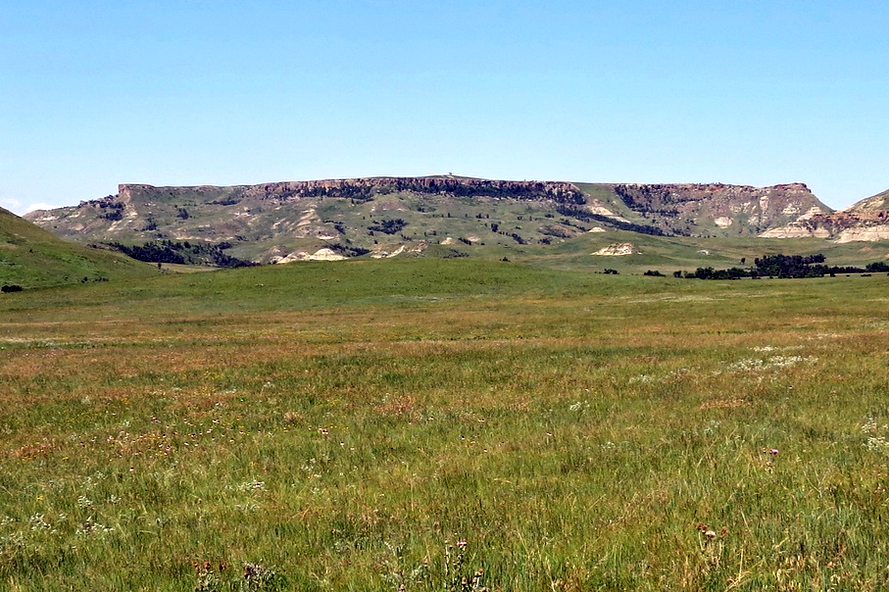
Much of the time we were on a high divide between two creek systems, from which we could see the great landmarks of all the regions roundabout—Sentinel Butte, Square Butte and Middle Butte, far to the north and east of us. Nothing could be more lonely and nothing more beautiful than the view at nightfall across the prairies to these huge hill masses, when the lengthening shadows had at last merged into one and the faint glow of the red sun filled the west. The rolling prairie, sweeping in endless waves to the feet of the great hills, grew purple as the evening darkened, and the buttes loomed into vague, mysterious beauty as their sharp outlines softened in the twilight.
Even when we got out of reach of the sheep men we never found antelope very plentiful, and they were shy, and the country was flat, so that the stalking was extremely difficult; yet I had pretty good sport. The first animal I killed was a doe, shot for meat, because I had twice failed to get bucks at which I emptied my magazine at long range, and we were all feeling hungry for venison. After that I killed nothing but bucks. Of the five antelope killed, one I got by a headlong gallop to cut off his line of flight. As sometimes happens with this queer, erratic animal, when the buck saw that I was trying to cut off his flight he simply raced ahead just as hard as he knew how, and, as my pony was not fast, he got to the little pass for which he was headed 200 yards ahead of me. I then jumped off, and his curiosity made him commit the fatal mistake of halting for a moment to look round at me. He was standing end on, and offered a very small mark at 200 yards; but I made a good line shot, and, though I held a trifle too high, I hit him in the head, and down he came. Another buck I shot from under the wagon early one morning as he was passing just beyond the picketed horses. The other three I got after much maneuvering and long, tedious stalks.
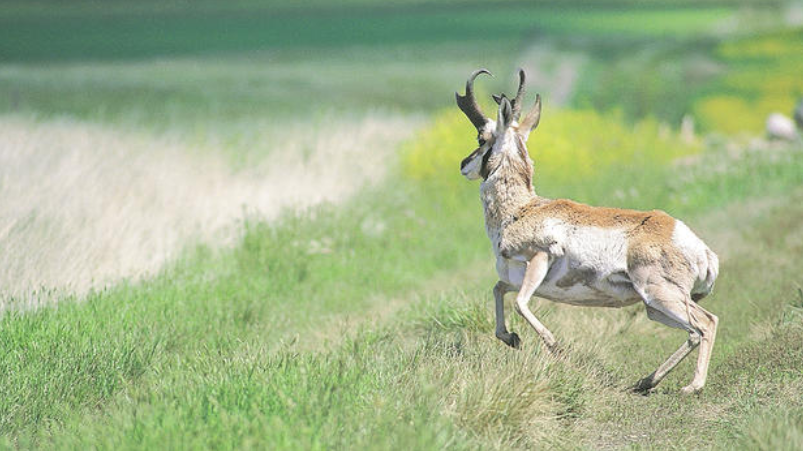
In some of the stalks, after infinite labor, and perhaps after crawling on all fours for an hour, or pulling myself flat on my face among some small sagebrush for ten or fifteen minutes, the game took alarm and went off. Too often, also, when I finally did get a shot, it was under such circumstances that I missed. Sometimes the game was too far; sometimes it had taken alarm and was already in motion. Once in the afternoon I had to spend so much time waiting for the antelope to get into a favorable place that, when I got up close, I found the light already so bad that my front sight glimmered indistinctly, and the bullet went wild. Another time I met with one of those misadventures which are especially irritating. It was at midday, and I made out at a long distance a band of antelope lying for their noon rest in a slight hollow. A careful stalk brought me up within fifty yards of them. I was crawling flat on my face, for the crest of the hillock sloped so gently that this was the only way to get near them. At last, peering through the grass, I saw the head of a doe. In a moment she saw me and jumped to her feet, and up stood the whole band, including the buck. I immediately tried to draw a bead on the latter, and to my horror found that, lying flat as I was, and leaning on my elbows. I could not bring the rifle above the tall, shaking grass, and was utterly unable to get a sight. In another second away tore all the antelope. I jumped to my feet, took a snap shot at the buck as he raced round a low-cut bank and missed, and then walked drearily home, chewing the cud of my ill luck. Yet again in more than one instance, after making a good stalk upon a band seen at some distance, I found it contained only does and fawns, and would not shoot at them.
Three times, however, the stalk was successful. Twice I was out alone; the other time my foreman was with me, and kept my horse while I maneuvered hither and thither, and finally succeeded in getting into range. In both the first instances I got a standing shot, but on this last occasion, when my foreman was with me, two of the watchful does which were in the band saw me before I could get a shot at the old buck. I was creeping up a low washout, and, by ducking hastily down again and running back and up a side coulee, I managed to get within long range of the band as they cantered off, not yet thoroughly alarmed. The buck was behind, and I held just ahead of him. He plunged to the shot, but went off over the hill crest. When I had panted up to the ridge, I found him dead just beyond.
One of the antelope I killed while I was out on foot at nightfall, a couple of miles from the wagon; I left the shoulders and neck, carrying in the rest of the carcass on my back. On the other occasion I had my horse with me and took in the whole antelope, packing it behind the saddle, after it was dressed and the legs cut off below the knees. In packing an antelope or deer behind the saddle, I always cut slashes through the sinews of the legs just above the joints; then I put the buck behind the saddle, run the picket rope from the horn of the saddle, under the belly of the horse, through the slashes in the legs on the other side, bring the end back, swaying well down on it, and fasten it to the horn; then I repeat the same feat for the other side. Packed in this way, the carcass always rides perfectly steady, and can not, by any possibility, shake loose. Of course, a horse has to have some little training before it will submit to being packed.
The above experiences are just about those which befall the average ranchman when he is hunting antelope. To illustrate how much less apt he is to spend as many shots while after other game, I may mention the last mountain sheep and last deer I killed, each of which cost me but a single cartridge.
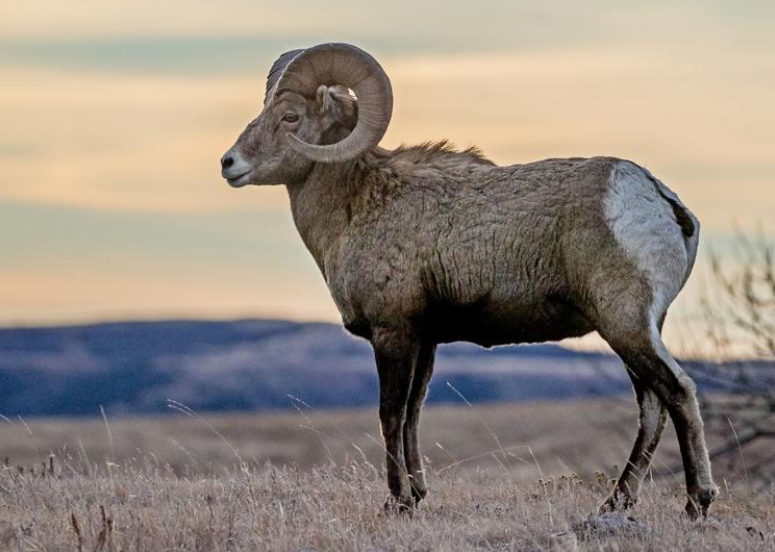
The bighorn was killed in the fall of 1894, while I was camped on the Little Missouri, some ten miles below my ranch. The bottoms were broad and grassy, and were walled in by rows of high, steep bluffs, with back of them a mass of broken country, in many places almost impassable for horses. The wagon was drawn up on the edge of the fringe of tall cottonwoods which stretched along the brink of the shrunken river. The weather had grown cold, and at night the frost gathered thickly on our sleeping bags. Great flocks of sandhill cranes passed overhead from time to time, the air resounding with their strange, musical, guttural clangor.
For several days we had hunted perseveringly, but without success, through the broken country. We had come across tracks of mountain sheep, but not the animals themselves, and the few blacktail which we had seen had seen us first and escaped before we could get within shot. The only thing killed had been a whitetail fawn, which Lambert had knocked over by a very pretty shot as we were riding through a long, heavily-timbered bottom. Four men in stalwart health and taking much outdoor exercise have large appetites, and the flesh of the whitetail was almost gone.
One evening Lambert and I hunted nearly to the head of one of the creeks which opened close to our camp, and, in turning to descend what we thought was one of the side coulees leading into it, we contrived to get over the divide into the coulees of an entirely different creek system, and did not discover our error until it was too late to remedy it. We struck the river about nightfall, and were not quite sure where, and had six miles’ tramp in the dark along the sandy river bed and through the dense timber bottoms, wading the streams a dozen times before we finally struck camp, tired and hungry, and able to appreciate to the full the stew of hot venison and potatoes, and afterward the comfort of our buffalo and caribou hide sleeping bags. The next morning the Sheriff’s remark of “Look alive, you fellows, if you want any breakfast,” awoke the other members of the party shortly after dawn. It was bitterly cold as we scrambled out of our bedding, and, after a hasty wash, huddled around the fire, where the venison was sizzling and the coffee-pot boiling, while the bread was kept warm in the Dutch oven. About a third of a mile away to the west the bluffs, which rose abruptly from the river bottom, were crowned by a high plateau, where the grass was so good that over night the horses had been led up and picketed on it, and the man who had led them up had stated the previous evening that he had seen what he took to be fresh footprints of a mountain sheep crossing the surface of a bluff fronting our camp. The footprints apparently showed that the animal had been there since the camp had been pitched. The face of the cliff on this side was very sheer, the path by which the horses scrambled to the top being around a shoulder and out of sight of camp.
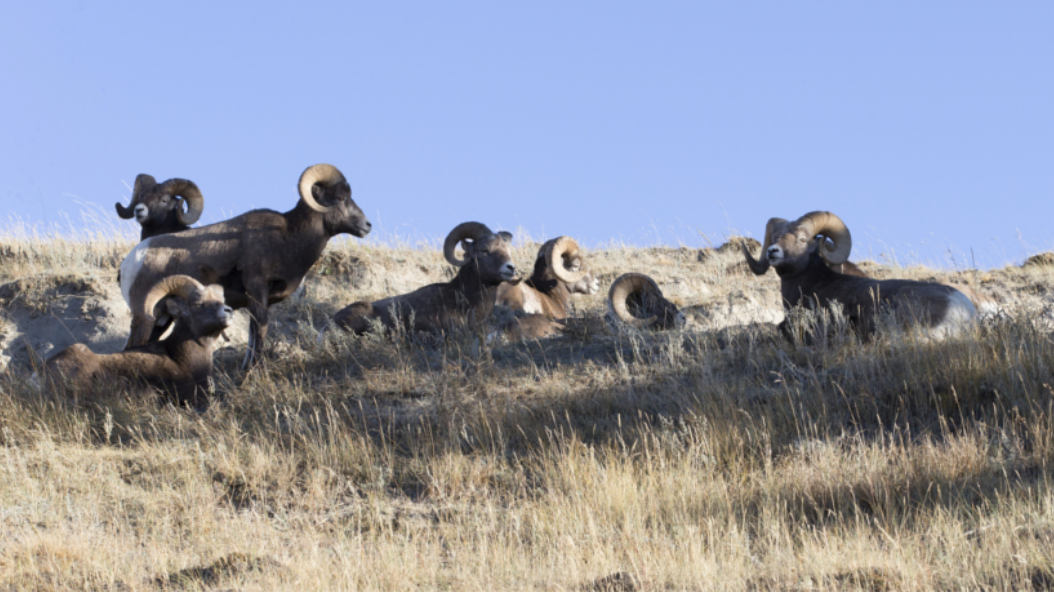
While sitting close up around the fire finishing breakfast, and just as the first level sunbeams struck the top of the plateau, we saw on this cliff crest something moving, and at first supposed it to be one of the horses which had broken loose from its picket pin. Soon the thing, whatever it was, raised its head, and we were all on our feet in a moment, exclaiming that it was a deer or a sheep. It was feeding in plain sight of us only about a third of a mile distant, and the horses, as I afterward found, were but a few rods beyond it on the plateau. The instant I realized that it was game of some kind I seized my rifle, buckled on my cartridge belt, and slunk off toward the river bed. As soon as I was under the protection of the line of cottonwoods, I trotted briskly toward the cliff, and when I got to where it impinged on the river I ran a little to the left, and, selecting what I deemed to be a favorable place, began to make the ascent. The animal was on the grassy bench, some eight or ten feet below the crest, when I last saw it; but it was evidently moving hither and thither, sometimes on this bench and sometimes on the crest itself, cropping the short grass and browsing on the young shrubs. The cliff was divided by several shoulders or ridges, there being hollows like vertical gullies between them, and up one of these I scrambled, using the utmost caution not to dislodge earth or stones. Finally I reached the bench just below the sky line, and then, turning to the left, wriggled cautiously along it, hat in hand. The cliff was so steep and bulged so in the middle, and, moreover, the shoulders or projecting ridges in the surface spoken of above were so pronounced, that I knew it was out of the question for the animal to have seen me, but I was afraid it might have heard me. The air was absolutely still, and so I had no fear of its sharp nose. Twice in succession I peered with the utmost caution over shoulders of the cliff, merely to see nothing beyond save another shoulder some forty or fifty yards distant. Then I crept up to the edge and looked over the level plateau. Nothing was in sight excepting the horses, and these were close up to me, and, of course, they all raised their heads to look. I nervously turned half round, sure that if the animal, whatever it was, was in sight, it would promptly take the alarm. However, by good luck, it appeared that at this time it was below the crest on the terrace or bench already mentioned, and, on creeping to the next shoulder, I at last saw it—a yearling mountain sheep—walking slowly away from me, and evidently utterly unsuspicious of any danger. I straightened up, bringing my rifle to my shoulder, and as it wheeled I fired, and the sheep made two or three blind jumps in my direction. So close was I to the camp, and so still was the cold morning, that I distinctly heard one of the three men, who had remained clustered about the fire eagerly watching my movements, call, “By George, he’s missed; I saw the bullet strike the cliff.” I had fired behind the shoulders, and the bullet, of course going through, had buried itself in the bluff beyond. The wound was almost instantaneously fatal, and the sheep, after striving in vain to keep its balance, fell heels over head down a crevice, where it jammed. I descended, released the carcass and pitched it on ahead of me, only to have it jam again near the foot of the cliff. Before I got it loose I was joined by my three companions, who had been running headlong toward me through the brush ever since the time they had seen the animal fall.
I never obtained another sheep under circumstances which seemed to me quite so remarkable as these; for sheep are, on the whole, the wariest of game. Nevertheless, with all game there is an immense amount of chance in the chase, and it is perhaps not wholly uncharacteristic of a hunter’s luck that, after having hunted faithfully in vain and with much hard labor for several days through a good sheep country, we should at last have obtained one within sight and earshot of camp. Incidentally I may mention that I have never tasted better mutton, or meat of any kind, than that furnished by this tender yearling.
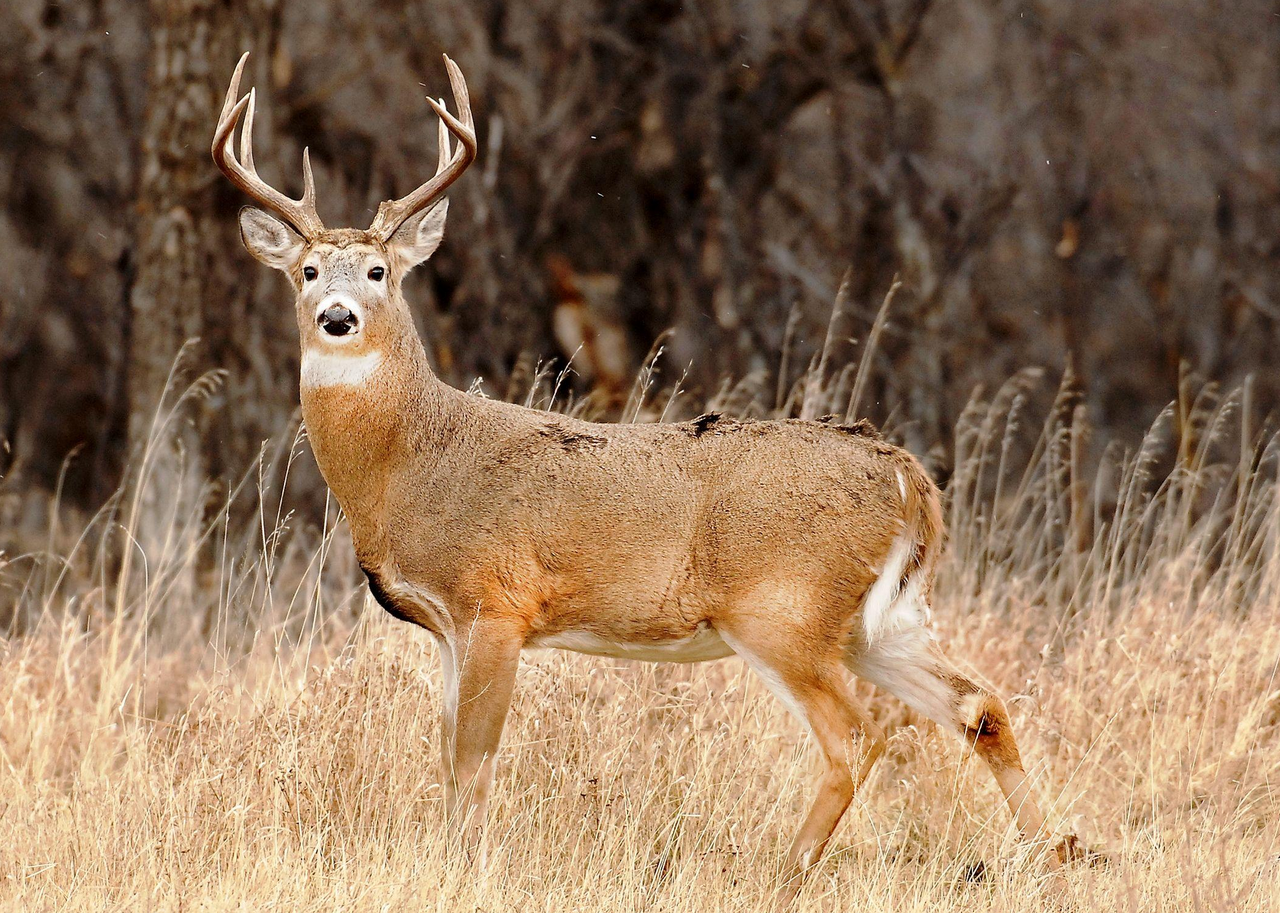
In 1894, on the last day I spent at the ranch, and with the last bullet I fired from my rifle, I killed a fine whitetail buck. I left the ranch house early in the afternoon on my favorite pony, Muley, my foreman riding with me. After going a couple of miles, by sheer good luck we stumbled on three whitetail—a buck, a doe and a fawn—in a long winding coulee, with a belt of timber running down its bottom. When we saw the deer, they were trying to sneak off, and immediately my foreman galloped toward one end of the coulee and started to ride down through it, while I ran Muley to the other end to intercept the deer. They were, of course, quite likely to break off to one side, but this happened to be one of the occasions when everything went right. When I reached the spot from which I covered the exits from the timber, I leaped off, and immediately afterward heard a shout from my foreman that told me the deer were on foot. Muley is a pet horse, and he enjoys immensely the gallop after game; but his nerves invariably fail him at the shot. He stood snorting beside me, and finally, as the deer came in sight, away he tore—only to go about 200 yards, however, and stand and watch us with his ears pricked forward until, when I needed him, I went for him. At the moment, however, I paid no heed to Muley, for a cracking in the brush told me the game was close, and in another moment I caught the shadowy outlines of the doe and the fawn as they scudded through the timber. By good luck, the buck, evidently flurried, came right on the edge of the woods next to me, and, as he passed, running like a quarter horse, I held well ahead of him and pulled the trigger. The bullet broke his neck and down he went—a fine fellow with a handsome ten-point head, and fat as a prize sheep; for it was just before the rut. Then we rode home, and I sat in a rocking-chair on the ranch house veranda, looking across the river at the strangely shaped buttes and the groves of shimmering cottonwoods until the sun went down and the frosty air bade me go in.
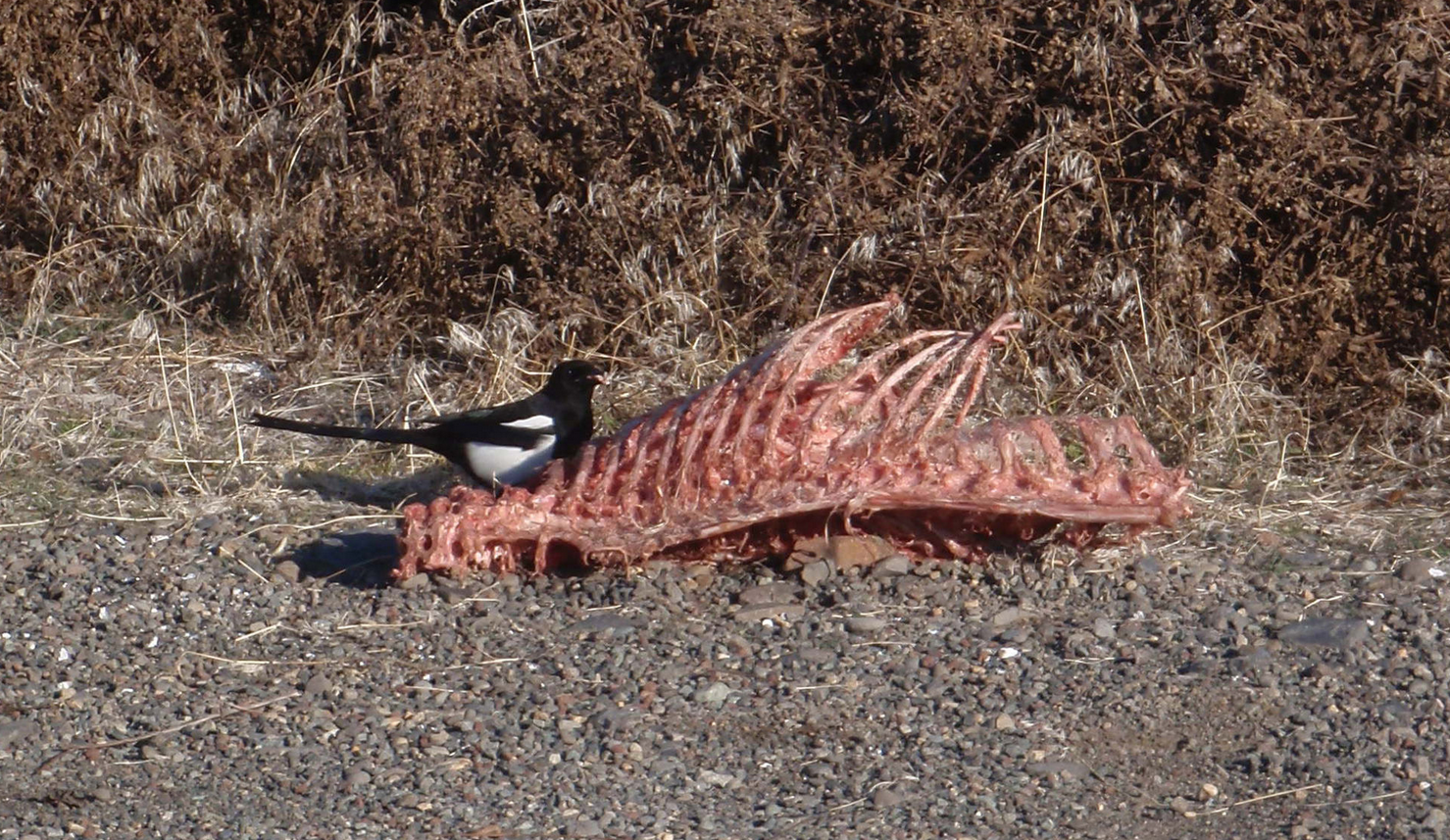
I wish that members of the Boone and Crockett Club, and big game hunters generally, would make a point of putting down all their experiences with game, and with any other markworthy beasts or birds, in the regions where they hunt, which would be of interest to students of natural history; noting any changes of habits in the animals and any causes that tend to make them decrease in numbers, giving an idea of the times at which the different larger beasts became extinct, and the like. Around my ranch on the Little Missouri there have been several curious changes in the fauna. Thus, magpies have greatly decreased in number, owing, I believe, mainly to the wolf-hunters. Magpies often come around carcasses and eat poisoned baits. I have seen as many as seven lying dead around a bait. They are much less plentiful than they formerly were. In this last year, 1894, I saw one large party; otherwise only two or three stragglers. This same year I was rather surprised at meeting a porcupine, usually a beast of the timber, at least twenty miles from trees. He was grubbing after sagebrush roots on the edge of a cut bank by a half-dried creek. I was stalking an antelope at the time, and stopped to watch him for about five minutes. He paid no heed to me, though I was within three or four paces of him. Both the luciver, or northern lynx, and the wolverine have been found on the Little Missouri, near the Kildeer Mountains, but I do not know of a specimen of either that has been killed there for some years past. The blackfooted ferret was always rare, and is rare now. But few beaver are left; they were very abundant in 1880, but were speedily trapped out when the Indians vanished and the Northern Pacific Railroad was built. While this railroad was building, the bears frequently caused much trouble by industriously damming the culverts.
With us the first animal to disappear was the buffalo. In the old days, say from 1870 to 1880, the buffalo were probably the most abundant of all animals along the Little Missouri in the region that I know, ranging, say, from Pretty Buttes to the Killdeer Mountains. They were migratory, and at times almost all of them might leave; but, on the whole, they were the most abundant of the game animals. In 1881 they were still almost as numerous as ever. In 1883 all were killed but a few stragglers, and the last of these stragglers that I heard of as seen in our immediate neighborhood was in 1885. The second game animal in point of abundance was the blacktail. It did not go out on the prairies, but in the broken country adjoining the river it was far more plentiful than any other kind of game. It is greatly reduced in numbers now. Blacktail were not much slaughtered until the buffalo began to give out, say in 1882; but they are probably now not a twentieth as plentiful as they were in that year. Elk were plentiful in 1880, though never anything like as abundant as the buffalo and the blacktail. Only straggling parties or individuals have been seen since 1883. The last I shot near my ranch was in 1886; but two or three have been shot since, and a cow and calf were seen, chased and almost roped by the riders on the round-up in the fall of 1893. Doubtless one or two still linger even yet in inaccessible places. Whitetail were never as numerous as the other game, but they have held their own well. Though they have decreased in numbers, the decrease is by no means as great as of the blacktail, and a good many can be shot yet. A dozen years ago probably twenty blacktail were killed for every one whitetail; now the numbers are about equal. Antelope were plentiful in the old days, though not nearly so much so as buffalo and blacktail. The hunters did not molest them while the buffalo and elk lasted, and they then turned their attention to the blacktails. For some years after 1880 I think the pronghorn in our neighborhood positively increased in numbers. In 1886 I thought them more plentiful than I had ever known them before. Since then they have decreased, and in the last two years the decrease has been quite rapid. Mountain sheep were never very plentiful, and during the last dozen years they have decreased proportionately less than any other game. Bears have decreased in numbers, and have become very shy and difficult to get at; they were never plentiful. Cougars were always very scarce.
There were two stages of hunting in our country, as in almost all other countries similarly situated. In 1880 the Northern Pacific Railroad was built nearly to the edge of the Bad Lands, and the danger of Indian war was totally eliminated. A great inrush of hunters followed. In 1881, 1882 and 1883 buffalo, elk and blacktail were slaughtered in enormous numbers, and a good many whitetail and prongbuck were killed too. By 1884 the game had been so thinned out that hide hunting and meat hunting had ceased to pay. A few professional hunters remained, but most of them moved elsewhere, or were obliged to go into other business. From that time the hunting has chiefly been done by the ranchers and occasional small grangers. In consequence, for six or eight years the game about held its own—the antelope, as I have said above, at one time increasing; but the gradual increase in the number of actual settlers is now beginning to tell, and the game is becoming slowly scarcer.
The only wild animals that have increased with us are the wolves. These are more plentiful now than they were ten years ago. I have never known them so numerous or so daring in their assaults on stock as in 1894. They not only kill colts and calves, but full-grown steers and horses. Quite a number have been poisoned, but they are very wary about taking baits. Quite a number also have been roped by the men on the round-up who have happened to run across them when gorged from feeding at a carcass. Nevertheless, for the last few years they have tended to increase in numbers, though they are so wary, and nowadays so strictly nocturnal in their habits, that they are not often seen. This great increase, following a great diminution, in the number of wolves along the Little Missouri is very curious. Twenty years ago, or thereabouts, wolves were common, and they were then frequently seen by every traveler and hunter. With the advent of the wolfers, who poisoned them for their skins, they disappeared, the disappearance being only partly explicable, however, by the poisoning. For a number of years they continued scarce; but during the last four or five they have again grown numerous, why I cannot say. I wish that there were sufficient data at hand to tell whether they have decreased during these four or five years in neighboring regions, say in central and eastern Montana. Another curious feature of the case is that the white wolves, which in the middle of the century were so common in this region, are now very rare. I have heard of but one, which was seen on the upper Cannon Ball in 1892. One nearly black wolf was killed in 1893.

I suppose all hunters are continually asked what rifles they use. Any good modern rifle is good enough, and, after a certain degree of excellence in the weapon is attained, the difference between it and a somewhat better rifle counts for comparatively little compared to the difference in the skill, nerve and judgment of the men using them. Moreover, there is room for a great deal of individual variation of opinion among experts as to rifles. I personally prefer the Winchester. I used a .45-75 until I broke it in a fall while goat-hunting, and since then I have used a .45-90. For my own use I consider either gun much preferable to the .500 and .577 caliber double-barreled Express for use with bears, buffalo, moose and elk; yet my brother, for instance, always preferred the double-barreled Express; Mr. Theodore Van Dyke prefers the large bore, and Mr. H. L. Stimson has had built a special .577 Winchester, which he tells me he finds excellent for grizzly bears. There is the same difference of opinion among men who hunt game on other continents than ours. Thus, Mr. Royal Carroll, in shooting rhinoceros, buffalo and the like in South Africa, preferred big, heavy English double-barrels; while Mr. William Chanler, after trying these same double-barrels, finally threw them aside in favor of the .45-90 Winchester for use even against such large and thick-hided beasts as rhinoceros. There was an amusing incident connected with Mr. Chanler’s experiences. In a letter to the London Field he happened to mention that he preferred, for rhinoceros and other large game, the .45-90 Winchester to the double-barrel .577, so frequently produced by the English gun makers. His letter was followed by a perfect chorus of protests in the shape of other letters by men who preferred the double-barrel. These men had a perfect right to their opinions, but the comic feature of their letters was that, as a rule, they almost seemed to think that Mr. Chanler’s preference of the .45-90 repeater showed some kind of moral delinquency on his part; while the gun maker, whose double-barrel Mr. Chanler had discarded in favor of the Winchester, solemnly produced tests to show that the bullets from his gun had more penetration than those from the Winchester—which had no more to do with the question than the production by the Winchester people of targets to show that this weapon possessed superior accuracy would have had. Of course, the element of penetration is only one of twenty entering into the question; accuracy, handiness, rapidity of fire, penetration, shock—all have to be considered. Penetration is useless after a certain point has been reached. Shock is useless if it is gained at too great expense of penetration or accuracy. Flatness of trajectory, though admirable, is not as important as accuracy, and when gained at a great expense of accuracy is simply a disadvantage. All of these points are admirably discussed in Mr. A. C. Gould’s “Modern American Rifles.” In the right place, a fair-sized bullet is as good as a very big one; in the wrong place, the big one is best; but the medium one will do more good in the right place than the big one away from its right place; and if it is more accurate it is therefore preferable.
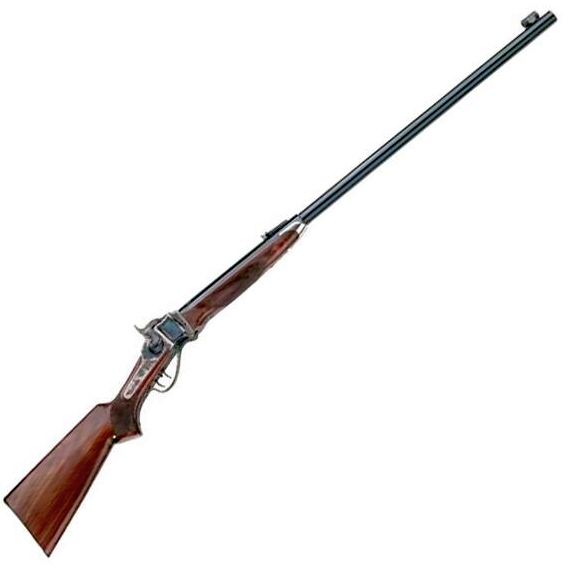
Entirely apart from the merit of guns, there is a considerable element of mere fashion in them. For the last twenty years there has been much controversy between the advocates of two styles of rifles—that is, the weapon with a comparatively small bore and long, solid bullet and a moderate charge of powder, and the weapon of comparatively large bore with a very heavy charge of powder and a short bullet, often with a hollow end. The first is the type of rifle that has always been used by ninety-nine out of a hundred American hunters, and indeed it is the only kind of rifle that has ever been used to any extent in North America; the second is the favorite weapon of English sportsmen in those grandest of the world’s hunting grounds, India and South Africa. When a single-shot rifle is not used, the American usually takes a repeater, the Englishman a double-barrel. Each type has some good qualities that the other lacks, and each has some defects. The personal equation must always be taken into account in dealing with either; excellent sportsmen of equal experience give conflicting accounts of the performances of the two types. Personally, I think that the American type is nearer right. In reading the last book of the great South African hunter, Mr. Selous, I noticed with much interest that in hunting elephants he and many of the Dutch elephant hunters had abandoned the huge four and eight bores championed by that doughty hunter, Sir Samuel Baker, and had adopted precisely the type of rifle which was in almost universal use among the American buffalo hunters from 1870 to 1883—that is, a rifle of .45 caliber, shooting 75 grains of powder and a bullet of 550 grains. The favorite weapon of the American buffalo hunter was a Sharps rifle of .45 caliber, shooting about 550 grains of lead and using ordinarily 90 to 110 grains of powder—which, however, was probably not as strong as the powder used by Mr. Selous; in other words, the types of gun were identically the same. I have elsewhere stated that by actual experience the big double-barreled English eight and ten bores were found inferior to Sharps rifle for bison-hunting on the Western plains. I know nothing about elephant or rhinoceros shooting; but my own experience with bison, bear, moose and elk has long convinced me that for them and for all similar animals (including, I have no doubt, the lion and tiger) the .45-90 type of repeater is, on the whole, the best of the existing sporting rifles for my own use. I have of late years loaded my cartridges not with the ordinary rifle powder, but with 85 grains of Orange lightning, and have used a bullet with 350 grains of lead, and then have bored a small hole, taking out 15 or 20 grains, in the point; but for heavy game I think the solid bullet better. Judging from what I have been told by some of my friends, however, it seems not unlikely that the best sporting rifle will ultimately prove to be the very small caliber repeating rifle now found in various forms in the military service of all countries—a caliber of say .256 or .310, with 40 grains of powder and a 200-grain bullet. These rifles possess marvelous accuracy and a very flat trajectory. The speed of the bullet causes it to mushroom if made of lead, and gives it great penetration if hardened. Certain of my friends have used rifles of this type on bears, caribou and deer; they were said to be far superior to the ordinary sporting rifle. A repeating rifle of this type is really merely a much more perfect form of the repeating rifles that have for so long been favorites with American hunters.
But these are merely my personal opinions; and, as I said before, among the many kinds of excellent sporting rifles turned out by the best modern makers each has its special good points and its special defects; and equally good sportsmen, of equally wide experience, will be found to vary widely in their judgment of the relative worth of the different weapons. Some people can do better with one rifle and some with another, and in the long run it is “the man behind the gun” that counts most.
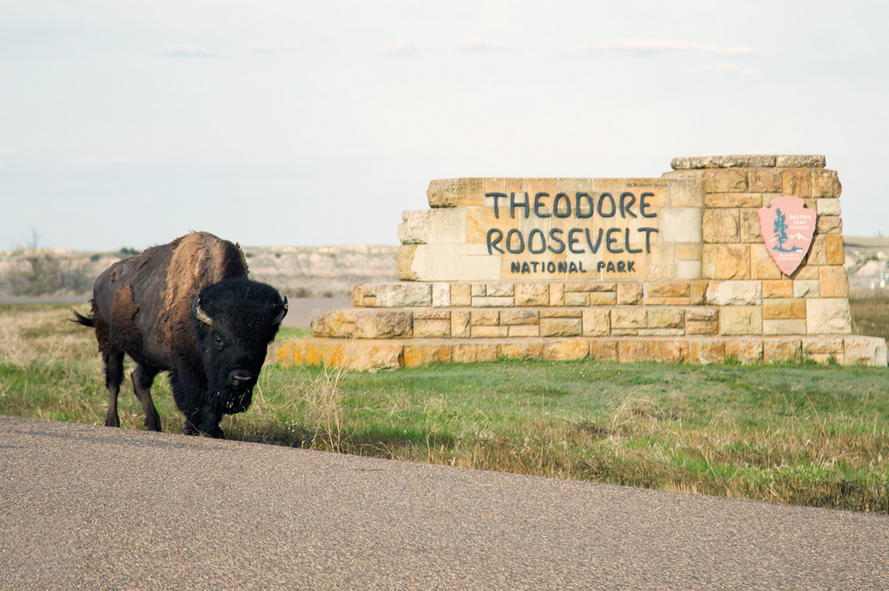

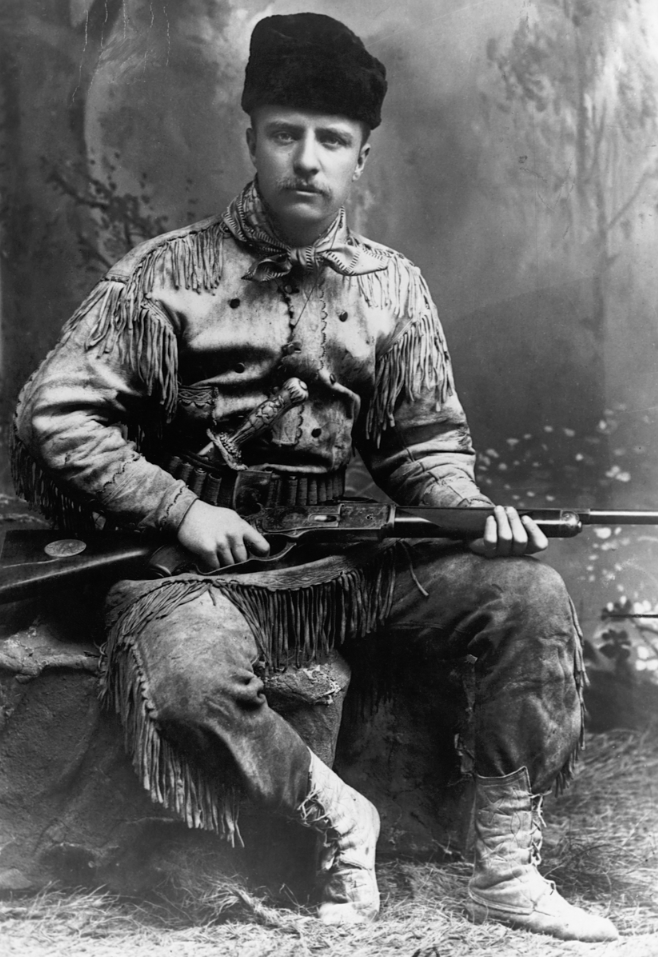


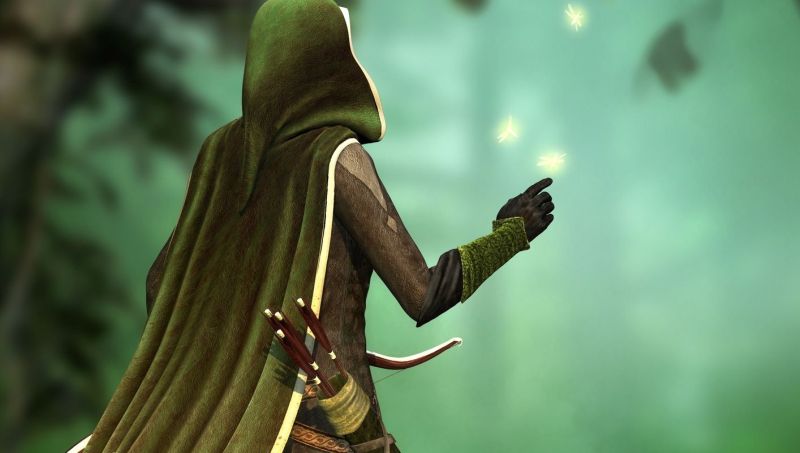
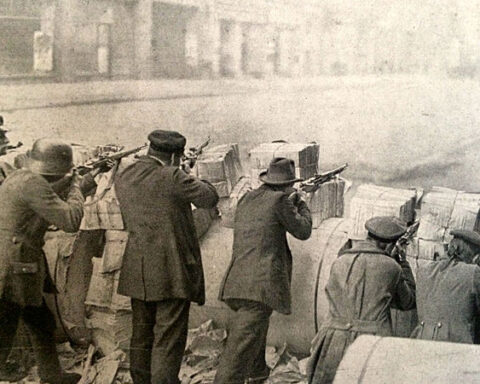
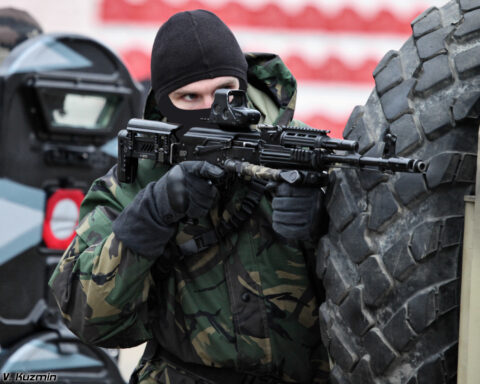

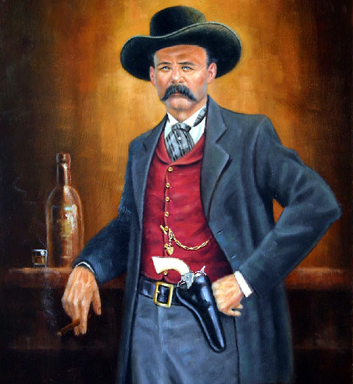
4
“and equally good sportsmen, of equally wide experience, will be found to vary widely in their judgment of the relative worth of the different weapons.” Ain’t that the truth.